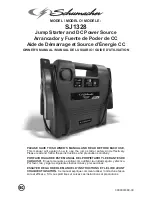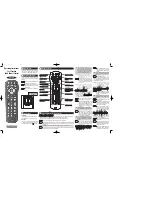
•
8
•
3.
Open the protective cover of the DC
power outlet on the jump starter.
4.
Plug the 12V DC device into the DC
power outlet and turn on the 12V DC
device (if required).
5.
If the 12V DC device draws more than
15A or has a short circuit, the internal
circuit breaker of the jump starter will
trip and disconnect the power to the
device. Disconnect the 12V DC device.
The breaker will automatically reset
after an overload occurs.
6.
When finished, turn off the DC device
(if required) and unplug from the DC
power outlet.
CAUTION:
Do not use the jump starter to
run appliances that draw more than 15A DC.
NOTE:
Extended operation of a 12V DC
device may result in excessive battery drain.
Recharge the jump starter immediately after
unplugging the 12V DC device.
12V DC ESTIMATED RUN-TIMES
APPLIANCE TYPE
EST
WATTAGE
ESTIMATED
RUN TIME
Cell phone
4 watts
54 hrs
Fluorescent light
4 watts
54 hrs
Radio, fan
9 watts
24 hrs
Depth finder
9 watts
24 hrs
Camcorder
15 watts
14.4 hrs
Electrical tool
24 watts
9 hrs
Electric cooler
48 watts
4.5 hrs
Car vacuum,
air compressor
80 watts
2.7 hrs
NOTE:
Actual time may vary. Times are based
on the internal battery being fully charged.
7. MAINTENANCE INSTRUCTIONS
7.1
After use and before performing
maintenance, unplug and disconnect
the jump starter.
7.2
Use a dry cloth to wipe all battery corrosion
and other dirt or oil from the battery clips,
cords and the jump starter case.
7.3
Ensure that all of the jump starter
components are in place and in good
working condition.
7.4
All servicing should be performed by
qualified service personnel.
8. MOVING AND STORAGE INSTRUCTIONS
8.1
Store inside, in a cool, dry place.
8.2
Do not store the clips on the handle,
clipped together, on or around metal, or
clipped to cables. The clips on the jump
starter are live when the switch is in the
ON position and will produce arcing or
sparking if they come in contact with each
other. To prevent accidental arcing, always
place the switch in the OFF position and
keep the clips on the storage holders when
not using it to jump start a vehicle.
8.3
If the jump starter is moved around the
shop or transported to another location,
take care to avoid/prevent damage to the
cords, clips and jump starter. Failure to
do so could result in personal injury or
property damage.
IMPORTANT:
Do not use and/or store the
jump starter in or on any area or surface
where damage could occur if the internal
battery should unexpectedly leak acid.
8.4 IMPORTANT:
• CHARGE IMMEDIATELY AFTER
PURCHASE
• KEEP FULLY CHARGED
Charge the jump starter’s internal battery
immediately after purchase, after every
use and every 30 days.
All batteries are affected by temperature. The
ideal storage temperature is at 70
°
F. The
internal battery will gradually self-discharge
(lose power) over time, especially in warm
environments. Leaving the battery in a
discharged state may result in permanent
battery damage. To ensure satisfactory
performance and avoid permanent damage,
charge the internal battery every month.
9. TROUBLESHOOTING
PROBLEM
POSSIBLE CAUSE
SOLUTION
The jump starter won’t
jump start my car.
Clamps are not making a good
connection to the battery.
Connections are reversed.
The jump starter’s battery is not
charged.
The vehicle’s battery is defective.
Check for poor connection to
battery and frame. Make sure
connection points are clean.
Disconnect the jump starter and
reverse the clamps.
Press the Battery Status button
on the front of the unit. The LEDs
will indicate the status of charge.
Have the battery checked.









































